Dogs paw pads can widely vary in color, from pink, black, dark brown, or tan, and can even be grey or white. Some dogs even have patchy paws in a different combination of colors depending on their breed and skin color. If their paws are pink, there shouldn’t be anything to worry about. But if you are concerned and your dog looks like they are in pain, then maybe you should contact your local vet.
Table of Contents
- About Dog Paws
- Why Are My Dog’s Paws Changing color?
- How Should I Treat My Dogs Paw Pads?
- How Can I Treat My Dog’s Red Paw Pads At Home?
- Why Your Dogs Paws Are Turning Red – ANSWERED!
- FAQs
About Dog Paws
While dogs’ paws can feel like rough leather, they are made from the epidermis, which is tough outer skin, like the soles of human feet. The major difference between dogs’ paws and human feet is the fact that they walk around on their bare paws all the time, while we always wear shoes.
Sometimes dogs’ paws can become rough if they have damaged their paws a little, or the surface that they walk on mostly is quite rough. Healthy dogs’ paws are usually smooth and should be free from any damage like abrasions.
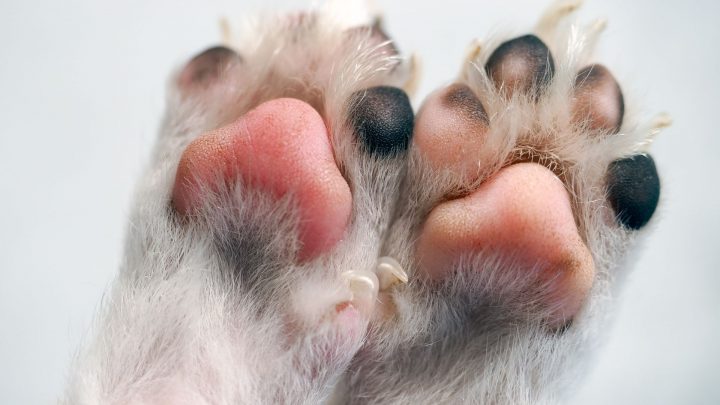
Puppies’ Paw Pads
The color of a puppy’s paw pads is pre-determined by their genetics. Like their nose, fur, and skin color, these factors all depend on their genetics.
You may notice when you first get your puppy that their paws are pink, or even just lightly colored, and over time the color of their paws changes slightly and perhaps gets darker over time. As puppies grow older, as we all know they go through many changes. Their paws are no exception to this. Some puppies go through ‘marbling’ of their paws.
As they grow older, the skin on the inside of their mouth, their paws, and nose sometimes changes from pink to brown or black.
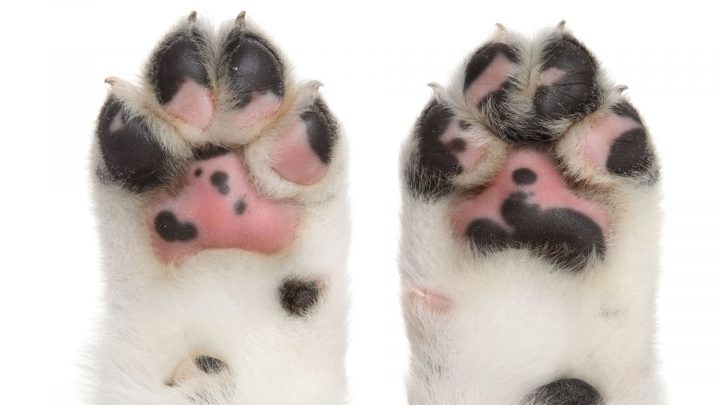
Why Are My Dog’s Paws Changing color?
If your dog is a bit older and fully grown, seeing their paws change color may mean something different. There are a few different reasons this may be happening.
Go through the list below to see if your dog is showing any of the accompanying symptoms in order to figure out the root of the cause.
Allergies
Just like humans, dogs’ skin can also go red from allergies. Food or contact allergies are usually the most common reason for your dog’s paws to turn pink. It is important to remember that humans aren’t the only ones who can contract allergies from their food and surroundings.
Have you noticed your dog displaying any symptoms of itching or inflammation? In addition to the irritation of their paws and any redness or inflammation of their skin, you may also notice that they are excessively scratching, licking, or biting the affected area.
Just like humans, your dog will behave in a similar way to us when they have an allergic reaction.
While the scratching relieves the itch, it can cause the skin to become irritated further.
One of the most common allergies that dogs have is to grass. Dust is another common allergy for dogs to have. You’ll understand why their paws may be the first to react to these substances because their paws will most likely be the first thing to encounter them.
When it comes to food allergies, grains are usually the most common type of food allergy that dogs can have. Like humans, dogs can also have a wheat intolerance which can cause them to be sick. It is unlikely that their paws would be the first sign of this allergen, but it is good to keep it in mind.
Either way, both types of allergies can cause itchy, irritated-looking pink paws. It is likely you will also see other areas of your dog’s skin become irritated and see them licking frequently. Other symptoms of this kind of allergy are sneezing, watery eyes, and even frequent ear infections caused by the allergy.
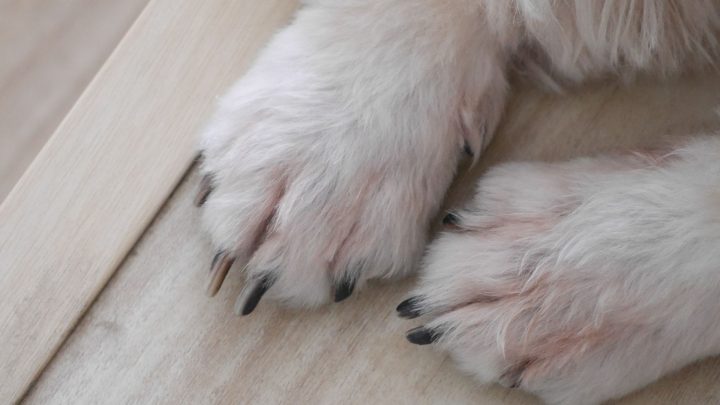
Infection
Bacterial and fungal infections can also cause your dog’s paws to turn pink or red. Another common symptom of fungal infections can include discharge, while bacterial infections are more commonly associated with pus-filled blisters.
Interestingly, bacterial infections are more commonly found in dogs’ front paws. This can be caused by ingrowing hairs between their toes, which can cause the infection. This can cause their paws to blister which will pop and reoccur until the condition has been treated, so it is best to deal with this as soon as possible to avoid severe discomfort for your pooch while avoiding further complications with infection from dirt entering a popped blister.
Infection can also be caused by walking in contaminated water with raw skin, which may have been caused by accidentally standing on a thorn or something that would break the skin.
Blisters and Burns
In the hot weather, it is especially important to look after your dog’s paws, because the floor can get super-hot without us realizing it. This will be sure to turn your dog’s paws pink.
Adult dogs have two layers of skin on their paws. They have a tougher, rougher, outer layer which is usually black. Underneath is a softer, pink layer to their paws, and is usually smooth.
Burns and blisters can cause this tough exterior layer to peel away and expose the interior layer, leaving their paws looking red and irritated.
As previously mentioned, paw burns are most common in the summer months. They can be caused by walking on a hot rock, concrete, or asphalt which is exposed to the sun all day. A dog’s temperature tolerance is actually similar to that of a human, so you can easily test out the temperature using your feet or hands to know if the floor temperature is suitable for your dog’s paws.
If the floor temperature is too hot your you, you can presume that it is also too hot for your dog. Any temperature of surfaces that surpasses 140 degrees Fahrenheit can cause serious damage to your dogs paws, and risk seriously burning your dog’s paws. Be especially aware of walking on black surfaces that are exposed in the sun, because dark or black surfaces will be especially hot as black attracts the heat.
Lighter colors are a bit safer than their counterpart, because they reflect heat. Choose white sidewalks to to alk on as these will be cooler. Overall, keep in mind that even these may be too hot on very bright days, and can depend on the breed of your dog, or the toughness of their paws.
Change in Walking Surface
A change in the surface in which you are walking on can also cause your dog’s paws to turn pink. More abrasive surfaces such as concrete, pavement, or gravel can irritate your dog’s paws, especially if they are used to walking on softer surfaces like grass.
If you have an indoor dog that is used to talking on carpet or smooth tiles, or wooden flooring, you should pay awareness to the type of surface they are walking on when outdoors.
Aging
As I’ve previously mentioned, puppies’ paws change color as they get older and change into adulthood. This is known as marbling and can occur on their nose, paws, and even just their skin.
Genetics
Again, genetics plays a big role in the color of your dog’s paws. It is quite common for dogs with white fur or lighter-colored fur, in general, to have pink skin underneath. There is nothing to worry about in this instance, you just may need to pay particular care to their skin in hot weather.
Just like humans, dogs with lighter-colored skin are more susceptible to getting sunburned. Be aware of light-colored noses on sunny days.
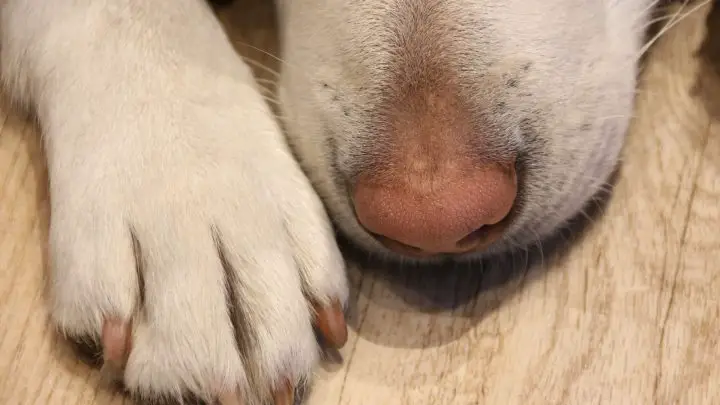
How Should I Treat My Dogs Paw Pads?
The cause of your dog’s paws turning pink will affect how to treat this problem greatly.
There are many ways in which you can overcome this problem, which I will list below.
Visit The Vet
In most cases, you may need to refer directly to the vet for proper evaluation. This is particularly important if you notice your dog’s paws have any sign of infection. This can be identified by any discharge, blisters, sign or injury, or burns.
If your dog looks like they are in pain when they are walking, it is important that this is also properly evaluated by their vet. You will need to keep an eye out for these signs. Unfortunately, your dog sadly can’t tell you when they are in pain. These signs include whining, limping, or avoiding activity.
If you notice your dog is licking more excessively than usual, then this can also be a sign that they are trying to give themselves relief, and are in need of a visit to the vet.
Antifungals and Antibiotics
Antifungals are a great method of treating yeast infections. These usually come in the form of either an oral medication or topical cream. Creams are usually enough to treat mild cases. More severe cases will require oral antifungal medication.
Antibiotics are similar but are used to treat bacterial infections. These too can be applied as a cream, or they can be administered as an oral medication.
Anti-inflammatory and steroids
Anti-inflammatory medications can be applied to your dogs paws to reduce the inflammation that you can see on their paws. They also help to reduce any pain that their paws may have.
Much like human medication, this administered to alleviate pain symptoms while reducing inflammation. In some cases, they are actually the same mediation, just administered in different doses.
Steroids are a bit more severe than anti-inflammatories, but they can be more effective is severe cases. In this case, they too are similar to human medication. They can be administered in oral tablet form, or they can be given as an injection.
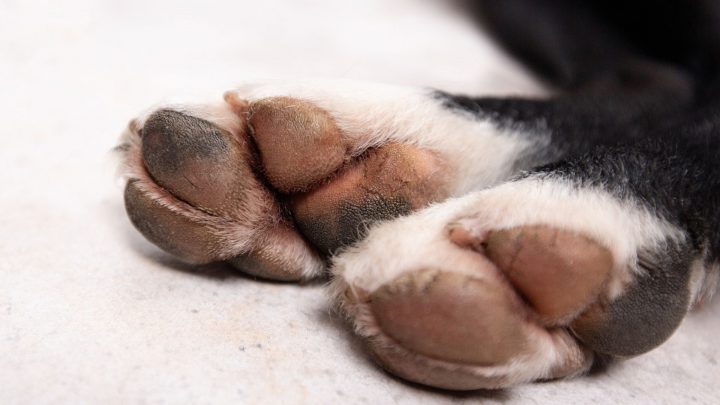
How Can I Treat My Dog’s Red Paw Pads At Home?
There are also a few different things that you can do at home to help treat and prevent your pooches’ paws from becoming inflamed. These are also great tricks for if you catch the signs of their paws turning pink early. Particularly when your dog is not showing any obvious signs of discomfort.
Paw Wax
This is a great product to use during the colder months. This prevents ice balls from sticking to your dog’s feet. This can really hurt their feet, and subsequently protects their feet from the cold.
This is not strong enough for very cold or rough conditions and shouldn’t be used in place of shoes in extreme weather. This also doesn’t work well for hot weather.
Avoid Hot Flooring
Be sure to check the surfaces of where you are walking when the weather is extremely hot.
Check the ground with your own foot (it may be best to wear sandals that can be easily slipped off) before letting your dog walk on it. This will help to avoid them burning their paws.
Stick to lighter-colored surfaces if you can as these won’t be as hot. And if you can’t, it may be worth investing in booties or dog shoes to protect their feet.
Regular Cleaning After Walking in Water
If your dog has spent parts of the day walking in water, it is good practice to wash their feet after. Water is a common way for dogs to get infections in their feet and can easily pick things up if they have any open wounds on their feet.
Avoid Allergens
If you have established your dog has a food allergy, it is easy to treat it, Make sure you keep the allergen out of their food and feed them hypoallergenic foods. In the case of allergens to the elements such as grass or dust, dog shoes may come in handy in this instance.
Dog shoes can limit your dogs exposure to allergens, particularly grass if you have an indoor dog. If you put their shoes on just before they go outside and then give them a quick wash once they come back inside, you will be sure to keep their paws from getting irritated.
Shampoos and Foot Soaks
Shampoos and foot soaks can actually help a wide range of problems your dogs paws may have. Lime dip can kill many different bacteria, fungi, or even parasites such as fleas and mites.
These soaks are safe for animals of all ages and can help to alleviate painful symptoms your dog may be experiencing. You can purchase a highly recommended dog shampoo here:
Why Your Dogs Paws Are Turning Red – ANSWERED!
Hopefully, this list will help you get to the bottom of why your dogs paws have changed color. While some causes are not so severe, there are simple ways to alleviate any symptoms your dog may have.
Hopefully, this will get them back to their normal selves! If you think I have missed out on anything, please let me know in the comment!
FAQs
There are afew different reasons why your dogs back paws may have turned red – Allergies, fungal infections, parasites, dryness, or injury.
The change in the color of a dog’s paw pads might not be alarming at all. Rather than an infection of health concern, it largely is because of genetics.






